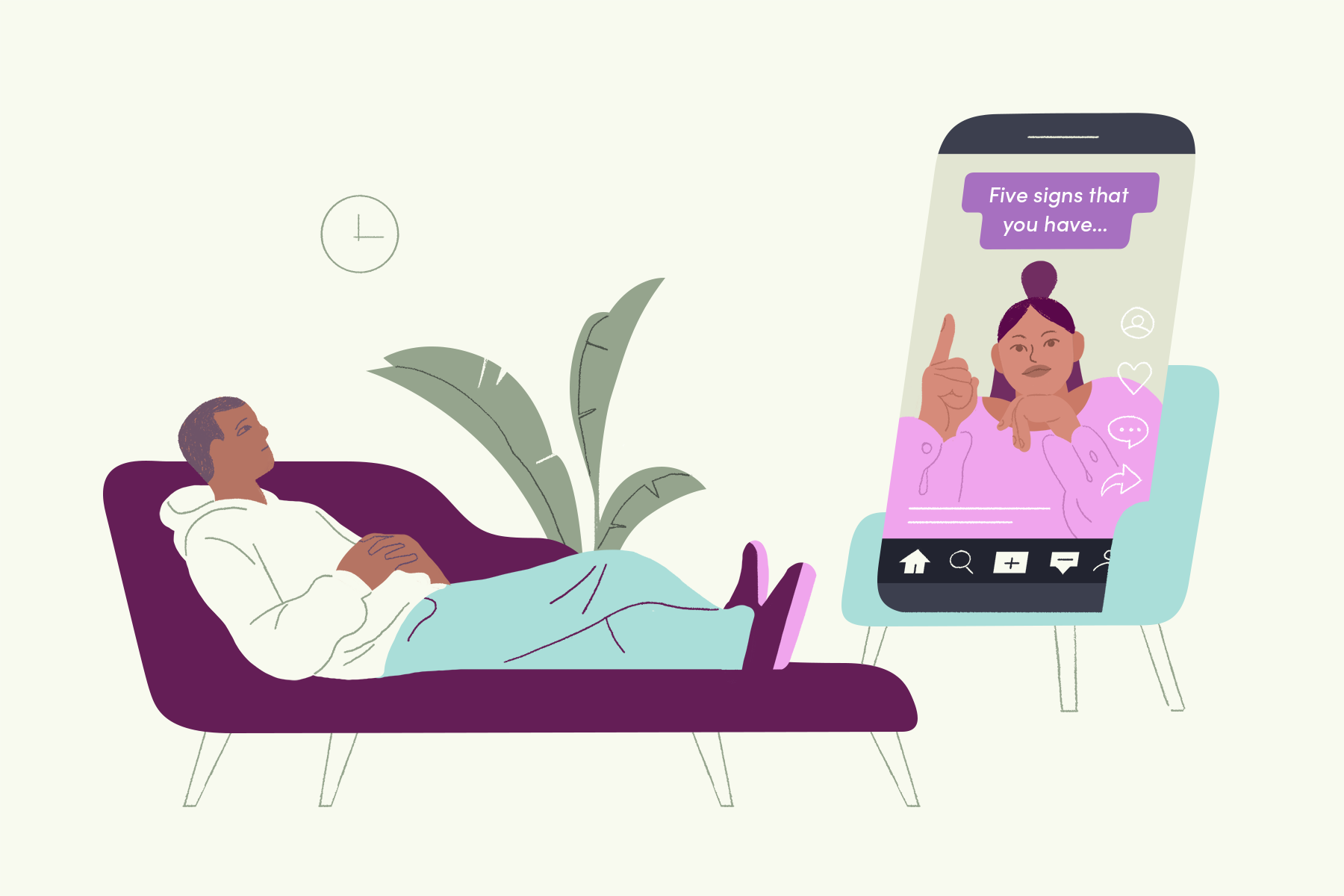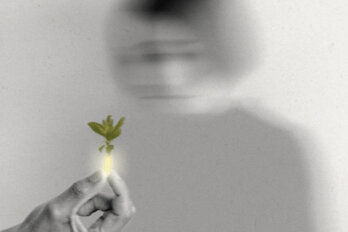For as long as I can remember, I’ve fallen firmly into the Canadian stereotype of unnecessarily apologizing, even when there’s nothing to apologize for. So often, “Oops, sorry!’’ has left my mouth before I’ve even had time to register what happened. It’s become such a common phrase in my vocabulary that I barely recognize when I say it anymore.
According to more than a few TikToks, unnecessary apologizing could be a symptom of latent anxiety, a way for my brain to get in front of a situation it registers as unpleasant. Other seemingly ordinary “symptoms” are laid out in many of these diagnosis videos, which often riff on the same formula: the creator stands in front of the camera, dancing, smiling, or pantomiming the words that pop up on the screen around them, like a modern version of a kabuki performance. In other variations, a fictional conversation unfolds between two characters played by the same person, usually ending in some revelation about their own habits.
The first time I saw one of these videos, I quickly scrolled past it. But, as more of them started to appear on my feed, I couldn’t help but wonder if my silly apologies were a sign of something deeper. The creators were convincing, and their proposed diagnoses did make a lot of sense when laid out so cleanly. Apparently, there were more habits I should be concerned about.
I love to wrap myself up like a burrito in a fuzzy blanket, and I have aversions to certain foods, like apple sauce and calamari, because their textures squick me out. Apparently, that could place me on the autism spectrum. I procrastinate sending emails all the time, just like someone with ADHD might. I also wear a lot of sweatshirts, which could be a sign of depression. It began to seem like nearly every behaviour I had was pathologized, emblematic of a larger problem I needed to explore.
Since the trend first appeared, in 2021, thousands of users have posted their own diagnosis videos. In June of that year, #ADHD had 4.1 billion global views on TikTok. By August, that number was 5.6 billion, and it’s since climbed to 10 billion. In some ways, the trend feels reflective of a new era for mental health—one when younger generations are more openly talking about their well-being. But condensing something as complex as a psychiatric disorder into a short, entertaining clip is a tough task. Can these videos actually help diagnose underlying mental health problems, or are they doing more harm than good?
Vipushi Sivanesanathan, a researcher and philosophy grad student at Queen’s University, has been tracking the ADHD hashtag on TikTok since last summer to learn more about how the platform affects the ways patients advocate for their treatments. Some of the videos she’s found list the symptoms of the disorder or include the personal experiences of the creators. Others, she says, go deeper, coaching people on what to say during doctor’s visits in order to get an ADHD assessment.
While Sivanesanathan thinks these TikToks are often created with good intentions, they offer only a one-note explanation of ADHD. If the viewer’s symptoms don’t line up with the video’s, they can be left wondering if there’s something more egregious going on. And, if their symptoms do match, what should they do next? The answer is not always clear.
The other issue, Sivanesanathan explains, is the TikTok algorithm itself. Users don’t have to follow creators to see their videos, so the home screen serves up a constant stream of new content. Since the app measures how long each user spends on a video to fine-tune its algorithm, a person who watches a TikTok on bipolar disorder could be fed more and more videos on the same subject. This has led Sivanesanathan to worry about confirmation bias. When the symptoms described in the videos are general and vague, people can usually find a way to relate them to their own lives—regardless of whether they actually have the disorder.
“Once you have that confirmation bias instilled in you, you may have lost this objective way of analyzing whether or not what you might have is ADHD,” Sivanesanathan says. The same goes for the other disorders commonly discussed on the platform, like autism, depression, anxiety, Tourette’s syndrome, and dissociative identity disorder. Since, according to Statista, over 80 percent of global TikTok users are twenty-four and under, diagnosis videos could have a huge impact on young people’s developing senses of self. Some viewers may recognize and identify with traits portrayed in viral TikTok videos. Others may, consciously or unconsciously, start to change their behaviour to match what they’re seeing.
Doctors have already seen a rise in patients, especially young women, presenting with physical tics common to Tourette’s syndrome patients. Notably, many of these patients started showing the symptoms after exposure to TikTok. While #Tourette’s now has 5.5 billion views on the platform, one study estimated that the disorder affects only about 0.05 percent of the adult population, which means many of the people seeking help for Tourette’s syndrome may not have it at all.
But many TikTok creators argue that the pros of these videos outweigh their cons. Influencing how younger users think about their mental health is the whole point since speaking more openly about these disorders—some of which are quite common—can reduce the stigma around them. And finding a community of people who think like you during a formative time in your life can be helpful for young people who might otherwise internalize the idea that something is wrong with them. There is power in recognition and representation. The creators I spoke with told me about the pride they feel helping others gain the language to describe their habits so they can better understand what might be affecting them.
Carley Richards, who goes by @adhadult on TikTok, says that a lot of people between the ages of twenty and forty have commented on their videos to say that they were inspired to get tested. For those who received a diagnosis, they add, it’s been life changing. The Ottawa-based creator has over 228,000 followers and posts regularly about their experiences with ADHD. While they didn’t start out with the aim of creating videos about mental health, they’re proud of the overall effect they’ve had. “I think my silly little TikTok videos are having a positive impact.”
Other creators, like Elita Reign, first recognized her own symptoms from TikTok and sees her content as a way of paying it forward. Reign was diagnosed with ADHD just last year, after she discovered TikToks that described her behaviours in a way that resonated. Now, she makes similar videos using informal language and fun songs, which she sees as an easier-to-understand alternative to something like the Diagnostic and Statistical Manual of Mental Disorders—a jargon-filled guide many doctors use to inform their diagnoses.
The hope is that these videos will lead viewers to formal diagnoses, but even if they don’t, having a way to self-identify can still be valuable. Many TikTokers are sharing not just what their lives are like but tips on how they manage school or work with their disorders. Richards has made several videos addressing the stigma around self-diagnosis and says, if the experiences of creators like them can help people find a community or feel better, “where is the bad?”
Put another way, a formal diagnosis is a privilege. In British Columbia, the average wait time to get an autism assessment from the provincial health authority is 1.6 years, according to the BC Autism Assessment Network. It’s possible to try to skip the wait with a private assessment, but those clinics can also have months-long wait lists and can cost nearly $3,000. In Ontario, an initial meeting for ADHD assessment at a private clinic can be more than $1,200. Even if people do have the funds to afford a private health care option, they still need to devote hours to calling clinics and travelling to appointments. Not everyone has access to this kind of mental health care.
TikTok can be a great entry point for someone seeking more information about their mental health, but the accessibility and simplicity of this information has merit only if it’s also accurate.
“I was scrolling my For You page and came across this video that said, ‘If you can hear this noise, you have ADHD.’ And I am absolutely positive that I don’t have ADHD. But I could hear this noise,” says Cecile Tucker, a registered clinical counsellor in British Columbia. People with ADHD may be hypersensitive to sounds, especially loud noises, but they don’t have an unusual pitch range or the ability to hear anything the rest of us can’t. The video stopped Tucker in her tracks. “I was like, Are people buying this? Are people believing this? So I looked in the comments. And there were many people saying, ‘Oh my gosh, does this mean I have ADHD?’”
Tucker also makes TikToks about mental health and therapy, including the symptoms and behaviours of trauma, and views them as an entry point for the curious. But who should make these kinds of videos? Should they have a clinical background? And are those creating content based on personal experience ultimately ascribing their own behaviours to a wider audience?
Christina Crowe, a TikTok creator and registered psychotherapist, says there’s a danger in not knowing how far your videos will reach. “In the end, you don’t know who your audience is, you don’t know who the most vulnerable person seeing your information is, you don’t know the constellation of comorbidities that they have.” Crowe sees herself and other mental health professionals on TikTok as working to dispel myths and offer up some counter information. But videos live and die by the algorithm, and health care professionals can’t control the whims or trends of the app. If their content doesn’t take off? Well, at least they tried.
“I think it’s positive that people want to take the reins and be in charge of navigating their health,” says Crowe. “And, in Canada, you absolutely have to do that.” The country’s mental health system is not easy or intuitive to navigate, and there are all sorts of barriers to access, including a lack of funding and a shortage of mental health care providers. (Less than 1 percent of our federal health care spending goes toward mental health.)
Ultimately, Crowe says, she’s noticed an improvement in the vocabulary of patients who come to see her, and for many, TikTok was a first step toward asking for help. “They get care faster, they demand more, and they recognize that they need more from their health care partners,” Crowe says. “It’s inspiring, and it’s quite a privilege to see.”
Like so many internet trends, TikTok diagnosis videos live in a grey area: they can be helpful or harmful, informative or misleading, depending on their nuance and accuracy. But, if viewers watch with a critical eye, what may seem at first like a silly little video has the potential to do a lot of good.





